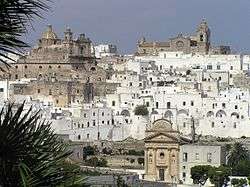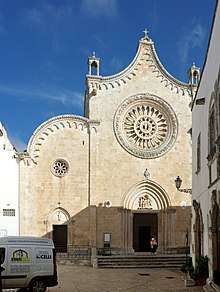Ostuni
Ostuni (Barese: Ostune; Salentino: Stune; Ancient Greek: Αστυνέον, romanized: Astynéon) is a city and comune, located about 8 km from the coast, in the province of Brindisi, region of Apulia, Italy. The town has a population of about 32,000 during the winter, but can swell to 100,000 inhabitants during summer, being among the main towns attracting tourists in Apulia. It also has a British and German immigrant community and an industrial zone. The region is a producer of high quality olive oil and wine.
Ostuni | |
|---|---|
| Comune di Ostuni | |
 Panorama of Ostuni | |
 Coat of arms | |
Location of Ostuni 
| |
 Ostuni Location of Ostuni in Italy  Ostuni Ostuni (Apulia) | |
| Coordinates: 40°44′N 17°35′E | |
| Country | Italy |
| Region | Apulia |
| Province | Brindisi (BR) |
| Frazioni | Barbagianni, Boccadoro, Cavallerizza, Cervaloro, Chiobbica, Costa Merlata, Deserto Parco Monsignore, Fantese, Galante, Giovannarocca, Grotta Figazzano, Monticelli, Pascarosa, Pilone, Pinto, Ramunno, Refrigerio, Rosa Marina, Villanova. |
| Government | |
| • Mayor | Gianfranco Coppola (Forza Italia) |
| Area | |
| • Total | 223 km2 (86 sq mi) |
| Elevation | 207 m (679 ft) |
| Population (31 December 2017)[2] | |
| • Total | 31,197 |
| • Density | 140/km2 (360/sq mi) |
| Demonym(s) | Ostunesi |
| Time zone | UTC+1 (CET) |
| • Summer (DST) | UTC+2 (CEST) |
| Postal code | 72017 |
| Dialing code | 0831 |
| Patron saint | St. Orontius of Lecce |
| Saint day | August 26 |
| Website | Official website |
History

The region around Ostuni has been inhabited since the Stone Age. The town is reputed to have been originally established by the Messapii, a pre-classic tribe, and destroyed by Hannibal during the Punic Wars. It was then re-built by the Greeks, the name Ostuni deriving from the Greek Astu néon ("new town").
Sacked after the fall of the Western Roman Empire, in 996 AD the town became part of the Norman County of Lecce .The Normans built their medieval town around the summit of the hill (229 m), with a castle (only remains can be seen) and city walls with four gates. From 1300 to 1463 it was part of the Principality of Taranto and from 1507 (together with what is now the frazione of Villanova and Grottaglie) passed to Isabella, Duchess of Bari, wife of Gian Galeazzo Sforza, Duke of Milan. Under Isabella's rule, Ostuni thrived during the Italian Renaissance. Isabella protected humanists and people of art and letters, including bishop Giovanni Bovio. She died in 1524 and Ostuni passed as a dowry to her daughter Bona Sforza, wife-to-be of Sigismund I of Poland, King of Poland. During Bona Sforza's government, Ostuni continued to enjoy a stable rule. In 1539 she had towers built along all the shoreline as protection against anticipated attacks from Turks who controlled the Balkans. These towers (still extant, including Pozzella Tower, the Pylon, Villanova and others), were garrisoned and communicated using fiery beacons.
Main sights

The "Old Town" is Ostuni's citadel built on top of a hill and still fortified by the ancient walls. Ostuni is commonly referred to as "the White Town" (La Città Bianca in Italian) for its white walls and its typically white-painted architecture. Monuments in their own right, the town's largest buildings are the Ostuni Cathedral and the Bishop's Palace, together with a number of palazzi of local aristocratic families: Aurisicchio, Ayroldi, Bisantizzi, Falghieri, Ghionda, Giovine, Jurleo, Marseglia, Moro, Palmieri, Petrarolo, Siccoda, Urselli and Zaccaria.
In the surrounding countryside there are typical Pugliese "masserie", fortified large estate-farms, one of which, San Domenico, was once held by the Knights of Malta.
Tourism

Ostuni is the fifth city in Italy by percentage of British residents and the first for sale of houses and villas. Starting from 2010, Ostuni and its nearest towns were characterized by so many arrivals from foreign countries, that some local and national newspapers coined a new term, "salentoshire" to describe this phenomenon, taking the term from the useful "chiantishire", taken for the similar phenomena that has characterized Tuscany some years ago.
References
- "Superficie di Comuni Province e Regioni italiane al 9 ottobre 2011". Istat. Retrieved 16 March 2019.
- Population from ISTAT
